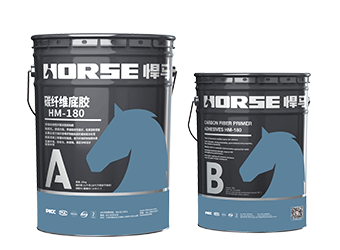Solutions
Horse Construction offers full range of structural strengthening materials with technical supports, documentation supports, products supports, project supports.
Study On The Fire Performance Of Carbon Fiber Reinforced Concrete Beams

Comparison of existing fire protection materials
Since CFRP itself does not have sufficient fire resistance, and CFRP is mainly used for reinforcement and repair, it is not used as a fire protection material. Therefore, the regulations require that after carbon fiber sheets strengthen the concrete structure, the surface of the structure that has been strengthened and repaired should be protected. . The fireproof materials selected and their treatment methods should make the reinforced building reach the required fireproof grade. When the reinforced structure is in other special environments, effective protective materials should be selected according to the specific conditions. The fire protection materials currently used for CFRP-reinforced concrete structures mainly include:
Thick fireproof paint, ultra-thin fireproof paint, fireproof board and ordinary cement mortar.

Main factors affecting fire resistance
According to the summary of the existing literature, the factors that affect the fire resistance of CFRP-reinforced concrete beams are: concrete protective layer thickness, load ratio, CFRP reinforcement amount, coating thickness, span-to-height ratio, and thermal performance of fireproof materials.
(1) CFRP reinforcement amount: the beam mid-span deflection increases as the CFRP reinforcement amount increases. Because the original reinforced concrete part will bear the load borne by the original CFRP when the CFRP reinforcement fails at high temperatures, as the amount of reinforcement increases, the mid-span deflection value increases. Therefore, both at home and abroad have made limitations on the increase in the bearing capacity of CFRP. The domestic code limits the increase in the bearing capacity of CFRP-reinforced concrete beams, which is 40%. The American standard ACI 440.2R-02 also indirectly limits the increase in the load-bearing capacity of CFRP to the member by stipulating the contribution of the original member's bearing capacity to the load after reinforcement to obtain the fire resistance limit required by the code.
(2) The thickness of the concrete protective layer: the deflection tends to decrease with the increase of the thickness of the concrete protective layer. Because the greater the thickness of the protective layer, the less the steel and concrete are affected by temperature, the more the resistance is exerted, and the smaller the deflection value.
(3) Load ratio: refers to the ratio of the bending moment of the mid-span section of the specimen under fire to the ultimate flexural capacity of the section at room temperature. The beam mid-span deflection increases with the increase of the load ratio. The smaller the coating thickness, the faster the change speed. Whether it is affected by high temperature or not, the greater the mid-span bending moment of the beam, the greater the mid-span deflection. Only under the action of high temperature, the deflection is more sensitive to the value of bending moment.
(4) Coating thickness: The deflection decreases as the coating thickness increases, and the smaller the height-span ratio, the faster the curve change rate, and the coating thickness has an economic value.
(5) Span-to-height ratio: The deflection increases with the increase of the span-to-height ratio. However, the magnitude of its change is still related to other parameters, such as the thickness of the concrete cover and the reinforcement ratio of the beam.
(6) Thermal performance of fireproof materials: thermal conductivity, mass heat capacity, mass density: as the thermal conductivity increases, the deflection of the beam gradually increases, but it does not change linearly. However, the influence of heat capacity and density values on the mid-span deflection tends to be insignificant. This is mainly because when the thermal conductivity is constant, the specific heat capacity and density have no significant influence on the temperature of the cross section, and the decrease in the resistance of the material and the increase in the mid-span deflection caused by the temperature are even more insignificant.
Generally speaking, among the many influencing factors, coating thickness, load ratio, and span-to-height ratio have obvious effects on fire resistance, while the effect of CFRP reinforcement, thermal performance of fireproof materials and concrete protective layer thickness is relatively small.
It is worth continuing to discuss the research aspects
1.The influence of end anchoring performance on the fire resistance of reinforced beams
The effect of improving the end anchoring performance on the fire resistance of the reinforced beam was studied by extending the CFRP cloth. Tests show that by strengthening the end anchoring of the beam, its fire resistance performance is improved. However, in actual engineering, for concrete beams to be strengthened, it is impossible to extend the CFRP cloth to the beam-column joints. Therefore, only additional anchors can be used to strengthen the end anchorage, and further research is still needed in this regard.
2. The necessity of strengthening the fire resistance of CFRP material itself
3. CFRP failure mode under fire action
Most of the existing literature studies assume that the failure mode of CFRP under fire is that the CFRP falls off due to the failure of the binder, and the failure mode of the fiber fracture of the CFRP-reinforced beam under the effect of temperature is rarely considered. The constitutive relationship models of these two failure modes are inconsistent, so it is necessary to consider the latter case in future research.
You can find anything here you are in need of, have a trust trying on these products, you will find the big difference after that.

High strength, unidirectional carbon fiber wrap pre-saturated to form a carbon fiber reinforced polymer (CFRP) wrap used to strengthen structural concrete elements.

Low viscosity, strong penetration carbon fiber primer for reinforced concrete surface to enhace the defect part

Good thixotropy carbon fiber leveling adhesive for concrete surface repairing